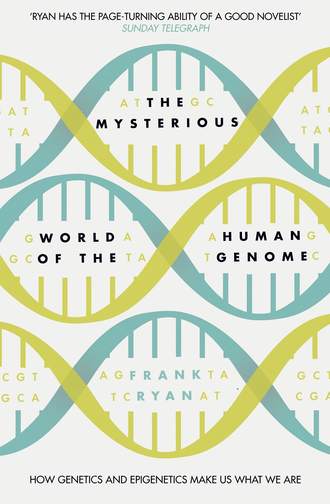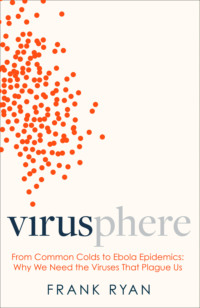
Полная версия
The Mysterious World of the Human Genome
Hydrogen bonds are something else.
Once again, we might take water as our example. But here we are looking at the chemical interactions between whole water molecules – the H2Os reacting with one another. There are forces of attraction, albeit rather weaker and less stable than covalent bonds, between certain molecules that contain both hydrogen and heavier atoms such as nitrogen, oxygen or fluorine. Since water contains hydrogen and oxygen, these hydrogen bonds can form between molecules of water – it is this sticking together of water molecules that explains the difference between water vapour, or steam, liquid water and solid water, or ice. In ice most of the molecules are attached to one another by hydrogen bonds, to form something like a crystal; in liquid water varying amounts are attached to one another; and in steam, as a result of the addition of energy through heating, the hydrogen bonds linking water molecule to water molecule are broken down but the covalent bonds linking atoms to atoms remain intact.
We see that hydrogen bonds are weak, and thus unstable when heated, but covalent bonds are stable. These same two bonds, covalent and hydrogen bonds, are important ingredients in the structure of organic chemicals such as proteins. And they are also important in the structure of DNA.
Between 1927 and 1932, Pauling published some fifty scientific papers in which he conducted X-ray diffraction studies, coupled with quantum mechanical theoretical calculations, leading him to postulate five rules, known as Pauling’s rules, that would help science to predict the nature of the bonds that held together atoms within molecules. At least three of these rules were based on Bragg’s own work, the purloining of which provoked Bragg to fury. It was now inevitable that there would be ongoing scientific rivalry between the two scientists. Pauling’s work into the nature of chemical bonding was so original, and pioneering, that he was awarded the Nobel Prize in Chemistry in 1954. Meanwhile, this new level of understanding enabled Pauling to visualise the precise shape and dimensions of molecules in three-dimensional space. Working at Caltech, Pauling applied this to the huge molecules of proteins, using the techniques of X-ray diffraction analysis pioneered by the Braggs. He showed, for example, that the haemoglobin molecule – the focus of Perutz’s research – changed its physical structure when it gained or lost an oxygen atom. And Pauling continued to apply his rules to researching the molecular structure of proteins.
Pioneering X-ray pictures of fibrous proteins had been obtained some years before at the University of Leeds by William Thomas Astbury, the physicist who had attended Wilkins’ talk in Naples, but it was assumptions based on these X-ray diffraction pictures that Crick was now questioning at the Cavendish Laboratory. For many years Pauling had tried to apply quantum mechanics calculations to Astbury’s X-ray pictures, but he found that things just didn’t add up. It would take him and two collaborators, Robert Corey and Herman Branson, fourteen years before they made the necessary breakthrough.
All proteins have a primary structure that is made up of an amino acid code, with the letters made up of twenty different amino acids. The chemical bonds that join up the amino acids into the primary chain are called ‘peptide bonds’. Pauling and his collaborators now realised that peptides bonded together in a flat two-dimensional plane – they called this ‘a planar bond’. A problem with outdated equipment had caused Astbury to make a critical error in taking his X-ray pictures: the protein molecules became tilted away from their natural planes, skewing the mathematical extrapolations of their structure. Once they had corrected Astbury’s error, Pauling and co discovered that as the chain of amino acids grew, to form the primary structure of proteins, it naturally followed the shape of a coiled spring, twisting to the right – the so-called ‘alpha helix’. This was the discovery that had excited Watson on his return trip from Naples.
Back in Cambridge, Sir Lawrence Bragg was bitterly disappointed when Pauling’s group beat his to the discovery of the primary structure of proteins. But there was a silver lining to the cloud: Perutz now used Pauling’s breakthrough to reappraise his own work on the haemoglobin molecule, a reappraisal that would solve the structural puzzle of haemoglobin and garner his Nobel Prize in Chemistry in 1963. Pauling’s discovery also alarmed Watson who, from his arrival at Cambridge, had assumed that they had a very knowledgeable and powerful rival in what was now a race to discover the three-dimensional structure of DNA.
*
But the problem, as Crick would point out in their day-to-day sharing of thoughts and incessant debate, was that they couldn’t even assume that Pauling’s data was right. In Crick’s words, ‘Data can be wrong. Data can be misleading.’ So Crick and Watson attempted to construct their physical model with a sceptical eye on prevailing experimental data. To put it another way, they relied just as heavily on creative leaps of their own imagination as on existing experimental data.
Crick and Watson were now asking themselves if DNA, like proteins, had a helical structure, and Watson in particular was convinced that they should also take their cue from Pauling, who liked to construct three-dimensional models of the molecules he was attempting to envisage. To do so they would have to think, as Pauling did, about the atomic structures that made up the chemistry of DNA – to fit the molecules, with their component atoms, and the bonds between them, into a complex three-dimensional jigsaw. They knew that they were dealing with the four nucleotides – guanine, adenine, cytosine and thymine – together with the molecule of the sugar, called ribose, and the inorganic chemical, phosphate, all of which, when correctly fitted together, must somehow make up the mysterious three-dimensional jigsaw puzzle.
Two relevant questions now loomed. Firstly, if the structure was helical, what kind of helix was involved? And secondly, where did the phosphate molecule fit into the structure? Calcium phosphate is the mineral of bones, of shells, of rocks formed from the remains of living marine organisms – limestone. The presence of phosphate suggested some kind of strengthening of the DNA chain – a chemical scaffold – maybe a spine? But where did this spine lie in relation to the presumptive and as yet unknown spiral? And where, or how, did the sugar fit in? The code itself must surely lie with the nucleotides, acting perhaps as something like letters. Each was a key ingredient, but how on earth did the whole thing assemble in a way that made sense?
An important clue must come from the X-ray diffraction patterns. That meant they needed the help of Maurice Wilkins and Rosalind Franklin – ‘Rosy’, as Watson referred to her in his autobiography – who were conducting X-ray analyses of DNA fibres at the King’s College London laboratory.
*
Rosalind Elsie Franklin was born in London to a prosperous Jewish family in 1920. From an early age she showed both a brilliantly incisive mind and the stubbornness necessary to make a distinguished mark for herself. She also showed an aggressively combative side to her personality that might prove a mixed blessing in overcoming the prevailing prejudices against Jews in society, as well as against women being in higher education and the scientific workplace. It didn’t help that her father, who appeared to be a similarly combative character to his daughter, opposed her notion of a career in science. In her second year at Newnham College, Cambridge, he threatened to cut off her fees, urging that she switch to some practical application in support of the war effort. Only when he was dissuaded by her mother and aunt did he relent and allow her to continue her course.
Franklin studied physical chemistry, which involved lectures, extensive reading and laboratory experience in physics, chemistry and the mathematics that applied to these disciplines. One of the mandatory texts she read was Linus Pauling’s The Nature of the Chemical Bond.
The youthful Rosalind Franklin was disappointed when she ended up with a good second, and not a first, ‘bachelor’s’ degree in 1941. Even then, such was the lingering prejudice against female graduates in science that she was forced to wait in an unseemly uncertainty, one shared with all previous female graduates of Newnham, until her due qualification was formally granted, retrospectively, in 1947.
Like Francis Crick, Franklin was seconded to National Service during the Second World War, studying the density and porosity of coal for a PhD, in which she helped to classify different types of coal in terms of fuel efficiency. Post-war, she followed this up with a research stint working under the direction of Jacques Mering at the Laboratoire Central des Services Chimique de l’Etat, in Paris. Here, Mering introduced her to the world of X-ray crystallography which he used to study the structure of fibres, such as rayon. ‘With his high tartar cheekbones, green eyes and hair combed rakishly over his bald spot’, Franklin was surprised to discover that Mering was Jewish, as well as being ‘the archetypal seductive Frenchman’. The still youthful, and perhaps naïve, Rosalind Franklin appears to have fallen in love with Mering, who was already married, but whose wife was ‘nowhere in evidence’.
Brenda Maddox, one of Franklin’s biographers, would draw attention to the fact that Franklin’s most imaginative and productive research was conducted when she was teamed up with male scientists of Jewish background. Mering also appeared to be attracted to the trim, slender young woman, with the lustrous dark hair and glowing eyes. They would spend entire days and on into the evenings deep in discussion and argument over likely meanings of X-ray plates and atomic structures.
However, Franklin’s infatuation with Mering would be painfully halted when, in January 1951, she took up a post as research associate at King’s College London in the Medical Research Council Biophysics Unit, directed by John Turton Randall. Her appointment happened to coincide with a major post-war rebuilding within the department, designed to accommodate new ambitions within the nascent field of biophysics. The precise nature and purpose of her appointment has since become the subject of debate. In part some confusion has arisen because Randall changed the scope of her appointment in between first confirming it and Franklin taking up the post. She had initially agreed to carry out X-ray diffraction studies of proteins, but Randall wrote to her before she took up her appointment, suggesting that she change direction to the study of DNA. According to Maurice Wilkins, this was at his suggestion. Whether at Wilkins’ suggestion or Randall’s own idea, Franklin agreed. She was offered the assistance of a promising graduate student, Raymond Gosling, to work with. But there was an inherent problem with this new direction.
Wilkins, who was Deputy Director of the MRC Unit based at King’s College, was the same scientist who had first lit the fuse of inspiration for Watson in the 1950 Naples lecture. Wilkins had initiated the research into DNA in the department, but happened to be deputising once again for Randall in America at the time of Franklin’s appointment. Up to now Gosling had been working with Wilkins on DNA; even after his return from America, Randall failed to inform Wilkins about the terms he now proposed for Franklin’s job description. This led to what Franklin’s later research colleague, Aaron Klug, would describe as ‘an unfortunate ambiguity about the respective positions of Wilkins and Franklin, which later led to dissension between them and about the demarcation of the DNA research at King’s’.
This is a short quote from the typed letter from Randall to Franklin, specifying her working conditions:
… as far as the experimental X-ray effort is concerned there will be at the moment only yourself and Gosling, together with the temporary assistance of a graduate from Syracuse, Mrs. Heller …
While this clearly suggests that Franklin was expected to take on the X-ray diffraction work, the qualification ‘at the moment’ is too vague to interpret. But there is nothing in this letter to suggest that Franklin should ignore the work performed by Wilkins, or that she should refuse to collaborate with the rest of the department in her approach to the DNA problem.
Wilkins, working with Gosling, had initiated the X-ray diffraction studies on DNA in the department, and in particular obtaining the best resolution diffraction photographs that existed up to this date. They had demonstrated a key property of DNA – that it had a regular, crystal-like molecular structure. In Paris Franklin had learned, and improved upon, X-ray diffraction techniques for dealing with substances of limited order. But even Klug, an ardent supporter of Franklin, admitted that in relation to the work conducted by Franklin in Paris, ‘It is important to realise … Franklin gained no experience of such formal X-ray crystallography.’
Back in early 1950 Wilkins had complained of poor-quality X-ray apparatus that was not designed for the scrutiny of exquisitely fine fibres. At his suggestion, the department had purchased a new and better-quality X-ray tube to be set up in the basement, but it had lain there for a year or more unused while Wilkins was distracted by the multiple tasks that fell to a busy deputy director of the unit. On her arrival, Franklin, not unnaturally, believed that she was there to take over the DNA work as her personal project. However, the returning Wilkins expected that Franklin had been brought in as his collaborator, to take up the research from where he had already developed it. He would subsequently admit that he was unqualified to take the X-ray diffraction work further and needed exactly such a dedicated and qualified collaborator. ‘That’s why we hired Rosalind Franklin.’
Unfortunately, Franklin and Wilkins now disagreed as to her role. Even so, rancour was neither necessary nor inevitable between the two scientists, personally or scientifically. These difficulties, provoked by Randall’s vagueness, might have been readily overcome with goodwill on both sides, but Franklin, in the opinion of both her biographers, was not inclined to cooperate.
Much has been written about prejudicial attitudes to women in science at this time. In particular an American journalist, and personal friend of Franklin’s, Anne Sayre, would write a biography of her in which she suggested that King’s College was particularly unfriendly to female scientists, with Franklin struggling to assert her presence in a domain that was almost exclusively male. But when another American journalist, Horace Freeland Judson, looked into this claim, he discovered that of the 31 staff working at King’s at this time, eight were female, including some working in a senior position in Franklin’s unit. A second biography of Franklin, by Brenda Maddox, confirmed that women were, on the whole, well treated at King’s College. Crick made the same point in his biography – and Crick had come to know Franklin well in the years following the DNA discovery. Even in Sayle’s more trivial complaint – that the main dining room was exclusively forbidden to women, who were thus precluded from lunchtime conversation – is misleading. There were two dining rooms. One was limited to men, but this, in the main, was used by Anglican trainees. The main dining room, used by the departmental staff, including Randall himself, was open to all.
The frosty relationship between Wilkins and Franklin was not the result of anti-female prejudice – it even seems unlikely to be the result of Randall’s peculiar wording in the letter – but it appears to be more directly related to a personality clash between the two scientists. Of the two, only Wilkins ever seems to have made any attempt at compromising. He asked other colleagues what he should do, but Alexander (Alec) Stokes, his closest colleague, was even meeker than he was. In Brenda Maddox’s opinion, the two should have got on well; Wilkins was gentle in manner and, despite his lack of self-confidence, was attractive to women. He was mathematically fluent and immersed in the very problems that concerned Franklin. But ‘confrontation’, in Maddox’s words, ‘was Franklin’s tactic, whenever cornered’. In an earlier confrontation with her professor, R. G. W. Norrish, when working on a postgraduate research project at Cambridge, she would confide, ‘When I stood up to him … we had a first-class row … he has made me despise him so completely I shall be quite impervious to anything he may say in the future. He gave me an immense feeling of superiority in his presence.’
Sayre, who championed her friend, would admit that Franklin’s ogrish depiction of her professor was unkind and inaccurate. Professor Norrish was awarded the Nobel Prize in Chemistry in 1967.
Sayre had a correspondence with Norrish in which she described Franklin as ‘highly intelligent … and eager to make her way in scientific research’, but also ‘stubborn, difficult to supervise’ and, perhaps most tellingly, ‘not easy to collaborate with’. In Maddox’s opinion, ‘If Rosalind had wished, she could have twisted Wilkins around her little finger.’ The fact is she had no wish to collaborate with him. This left Wilkins isolated locally so instead he turned to Crick and Watson at Cambridge. It also meant that Franklin was equally isolated. To the commonsensical Crick, this may have been a crucial factor when it came to working out the molecular structure of DNA. ‘Our advantage was that we had evolved … fruitful methods of collaboration, something that was quite missing in the London group.’
In that same year of Franklin’s appointment, just before Wilkins headed for America, he asked his colleague, Alec Stokes – another Cambridge-educated physicist – if he could work out what kind of diffraction pattern a helical molecule of DNA would project onto an X-ray plate. It took Stokes just twenty-four hours to do the mathematics, largely figuring it out while travelling home on the commuter train to Welwyn Garden City. A helical model fitted very closely with the picture Gosling and Wilkins had obtained in their diffraction pictures of DNA. It would appear that if anybody first confirmed that DNA had a helical structure, the credits must surely include Wilkins, Gosling and Stokes – the latter would subsequently lament that, in retrospect, he might have merited 1/5000th of a Nobel Prize.
In November 1951, Wilkins told Watson and Crick that he now had convincing evidence that DNA had a helical structure. Watson had only recently heard Franklin say something similar in a talk about her research during a King’s College research meeting. This inspired Watson and Crick to attempt their first tentative three-dimensional model for DNA.
But where to begin?
Taking their cue from Linus Pauling, Watson and Crick decided that they would attempt to construct a three-dimensional physical model of the atoms and molecules that made up DNA with their covalent and hydrogen bond linkages to one another. On the face of it, the structure was made up of a very limited number of different molecules. There were the four nucleotides – guanine, adenine, cytosine and thymine – but they also knew that the structure contained a sugar molecule, deoxyribose, and a phosphate molecule. The phosphate was likely to be playing a structural role, perhaps holding the thread together, much as phosphate is a key structural component of our bony human spine. In the colloquium at King’s, attended by Watson, such was his lackadaisical absence of focus that he completely missed the importance of Franklin’s statement that the phosphate-sugar ‘spines’ were on the outside, with the coding nucleotides, the GACT, on the inside. As usual, he had eschewed making notes. All that seemed to intrigue Watson was the fact that the King’s people were uninterested in the model-building approach developed, with such aplomb, by Pauling.
In 1952 Franklin appears to have undergone a drastic change of heart in her own thoughts on the structure of DNA. She had in her possession a brilliantly clear X-ray picture of DNA, taken by Gosling, that clearly showed a helical structure to the molecule. She called this her ‘wet form’, and also her ‘B form’. But she had even clearer pictures of a different structure of the same molecule in its ‘dry form’, or ‘A form’, that did not appear to suggest a helix. The contrast between the two forms caused Franklin to dither as to whether the DNA molecule was helical. There is a suggestion that she may have asked the opinion of an experienced French colleague, who advised her to place her bets on whichever form gave the clearest pictures. She must have been altogether aware of the advice her ignored colleague, Wilkins, would have given. Unfortunately, she ended up putting the B form into a drawer, meanwhile focusing most of her research over that year into the A form.
Early that same year Watson and Crick made a first attempt at building a triple-stranded helical model of DNA, with a central phosphate-sugar spine. When Wilkins brought Franklin and Gosling up to Cambridge to view the model, they broke out into laughter. The model was absolute rubbish. It did not fit at all with the X-ray diffraction predictions. Thanks to Watson’s lackadaisical focus, and his failure to take notes at Franklin’s colloquium, he had made the cardinal error of putting the phosphate-sugar spine at the dead centre of their helix and not on the outside, as Franklin and Gosling had clearly deduced.
Sayre, who rightly defended Franklin from the egregious caricature depicted by Watson’s book, loses track of the contribution of Wilkins and Gosling. It is true that Franklin and Gosling had produced some of the clearest pictures yet of the B form of DNA, pictures of such clarity that they did come astonishingly close to the truth of its molecular structure. But then, confused for a year by the two seemingly different patterns of the A and B forms, Franklin veered away from her own earlier conclusions and for a year she took the view that DNA wasn’t helical at all. Sayre appears to refute this, but Gosling would subsequently confirm Wilkins’ account of how, on Friday 18 July 1952, Franklin goaded Wilkins with an invitation to a wake. The invitation card announced, with regret, the death of the DNA helix (crystalline) following a protracted illness. ‘It was hoped that Dr M. H. F. Wilkins would speak in memory of the deceased.’ At the time Wilkins assumed it was typical of Gosling’s sense of humour. But many years later he would discover that it was Franklin who had written the card, and it confirmed her refutation of any helical structure of DNA in that confused year.
Конец ознакомительного фрагмента.
Текст предоставлен ООО «ЛитРес».
Прочитайте эту книгу целиком, купив полную легальную версию на ЛитРес.
Безопасно оплатить книгу можно банковской картой Visa, MasterCard, Maestro, со счета мобильного телефона, с платежного терминала, в салоне МТС или Связной, через PayPal, WebMoney, Яндекс.Деньги, QIWI Кошелек, бонусными картами или другим удобным Вам способом.






